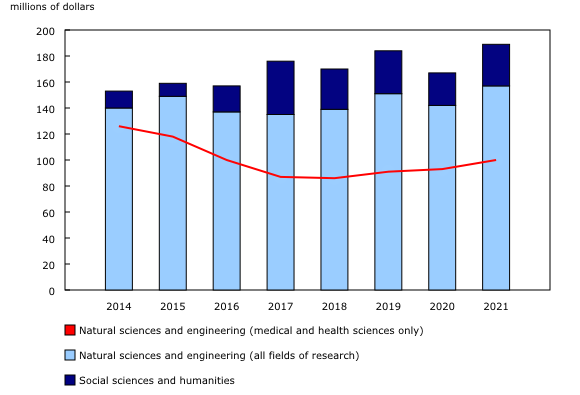Research and development of Canadian private non-profit organizations, 2021 (actual), 2022 (preliminary) and 2023 (perspectives)
Released: 2023-03-10
Canadian private non-profit organizations spent $189 million on in-house research and development (R&D) in 2021, representing a historic high in spending levels.
Current in-house R&D spending continued to be the main in-house expenditure in 2021, as spending reached $179 million (up 11.2% from 2020). Capital in-house R&D expenditures increased to $10 million in 2021, which is the highest level reported since 2014.
Total in-house R&D expenditures are expected to decline to $171 million in 2022 and slightly increase to $172 million in 2023.
Medical and health sciences remain the primary focus of research and development
In-house R&D spending is categorized into two main fields: the natural sciences and engineering, and the social sciences and humanities. Spending in the natural sciences and engineering field in 2021 made up the majority (83.1%) of in-house R&D expenditures.
Spending in the natural sciences and engineering field rose 10.6% to $157 million. The principal focus of R&D spending in this category remained in the medical and health sciences group ($100 million), with clinical medicine ($37 million) and health sciences ($38 million) accounting for three-quarters of this spending.
R&D spending in the social sciences and humanities increased to $32 million. This represents a rebound from a decrease in spending that occurred in this field in 2020, nearing previous spending levels reported in 2019 ($33 million).
Private non-profit organizations focus mainly on applied research and development
In-house R&D is categorized into three types: basic research (investigation of the underlying foundations of a phenomenon), applied research (original investigation of a phenomenon with a practical objective) and experimental development (creating an end product or process).
Applied research remained the focus of R&D ($105 million) in 2021, accounting for 55.6% of all in-house R&D expenditures, ahead of basic research ($52 million) and experimental development ($32 million). This focus of R&D differs from R&D conducted by businesses, where experimental development tends to be the priority.
In-house research and development personnel increase
In 2021, in-house R&D personnel increased 10.6% to 1,252 full-time equivalents (FTEs).
Private non-profit organizations also reported the gender of their in-house R&D personnel for the first time in 2021. Based on feedback from more than three quarters of organizations, which accounted for 50.3% of all personnel reported, about 47% of FTEs were male and around 53% of FTEs were female.
Outsourcing of research and development increase in 2021
Private non-profits outsourced $622 million (up 28.2%) of R&D to other organizations in 2021. Outsourcing within Canada accounted for $545 million of this total, which was captured mainly (87.5%) by hospitals ($311 million) and universities ($166 million).
Looking ahead, total outsourced R&D spending is anticipated to increase to $706 million in 2022 and decrease to $670 million in 2023.
Note to readers
Private non-profit organizations provide services to households either without charge or at prices that are not economically significant. For purposes of measuring research and development (R&D) performance, private non-profit organizations include voluntary health organizations, private philanthropic foundations and private research institutes.
The private non-profit sector is residual in nature. Private non-profit organizations that are controlled and financed by government (at least 50%) or affiliated with higher education institutions are excluded from the survey population. R&D expenditures for these excluded private non-profit organizations are included in the R&D expenditures for the government and higher education sectors. Control over private non-profit organizations may change over time, causing volatility within the sector's population.
Contact information
For more information, or to enquire about the concepts, methods or data quality of this release, contact us (toll-free 1-800-263-1136; 514-283-8300; infostats@statcan.gc.ca) or Media Relations (statcan.mediahotline-ligneinfomedias.statcan@statcan.gc.ca).
- Date modified:

